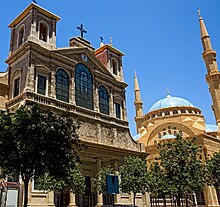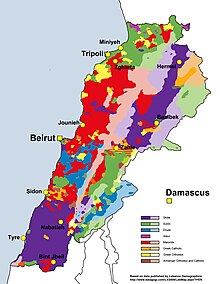This is an old revision of this page, as edited by MyVoiceIsHeard (talk | contribs) at 09:04, 13 October 2013 (Undid revision 575978377 by Elie plus (talk)). The present address (URL) is a permanent link to this revision, which may differ significantly from the current revision.
Revision as of 09:04, 13 October 2013 by MyVoiceIsHeard (talk | contribs) (Undid revision 575978377 by Elie plus (talk))(diff) ← Previous revision | Latest revision (diff) | Newer revision → (diff)
| Lebanon religions | ||||
|---|---|---|---|---|
| Religion | Percent | |||
| All Muslims | 54% | |||
| All Christians | 41.5% | |||
| Druze | 5.5% | |||
| Lebanon religious sects | ||||
|---|---|---|---|---|
| Religion | Percent | |||
| Sunni Islam | 27% | |||
| Shia Islam | 27% | |||
| Maronite Catholic | 21% | |||
| Greek Orthodox | 8% | |||
| Greek Catholic | 5% | |||
| Armenian Orthodox | 4% | |||
| other Christian denominations | 3% | |||
| Druze | 5% | |||


Lebanon has several different main religions. The country has the most religiously diverse society in the Middle East, comprising 17 recognized religious sects. The main two religions are Christianity (the Maronite Church, the Eastern Orthodox Church, the Armenian Apostolic Church, the Assyrian Church of the East) and Islam (Shia and Sunni). There is also the Druze minority religion. No official census has been taken since 1932, reflecting the political sensitivity in Lebanon over confessional (i.e. religious) balance.
A demographic study published in May 20, 2013 and conducted by the U.S. Department of State under the name 2012 Report on International Religious Freedom states that approximately:
- 54% Muslim (where 27% are Sunni and 27% are Shia)
- 41.5% Christian (where 21% Maronite, 8% Greek Orthodox, 5% Greek Catholic, 6.5% such as Armenian Orthodox, Syriac Catholic, Armenian Catholic, Syriac Orthodox, Roman Catholic, Chaldean, Assyrian, Copt, Protestant)
- 5.6% Druze, who do not consider themselves to be Muslims, in addition to small numbers of Lebanese Jews in which the majority are Mizrahi Jews, Bahais, Buddhists, Hindus, and members of The Church of Jesus Christ of Latter-day Saints (Mormons).
The CIA World Factbook shows that of those residing in Lebanon, 59.7% are Muslims (Sunni, Shia, Druze, Sufi and Alawites) and 39.0% are Christians (mostly Maronites, Greek Orthodox, Armenian Apostolic, Melkite Greek Catholics, Assyrian Church of the East, Syriac Orthodox, Chaldean Catholic, Syrian Catholics) and 1.3% "Other".
Lebanon has a population of Mhallamis also known as Mardinli), most of whom migrated from northeast Syria and southeast Turkey are estimated to be between 75,000 and 100,000 and considered to be part of the Sunni population. These have in recent years been granted Lebanese citizenship and, coupled with several civil wars between Islamic extremists and the Lebanese military that have caused many Christians to flee the country, have re-tipped the demographic balance in favour of the Muslims and the Sunnis in particular. In addition, many thousands of Arab Bedouins in the Bekaa and in the Wadi Khaled region, who are entirely Sunnis, were granted Lebanese citizenship. Lebanon also has a Jewish population, estimated at less than 100.
Even though Lebanon is a secular country, family matters such as marriage, divorce and inheritance are still handled by the religious authorities representing a person's faith. Calls for civil marriage are unanimously rejected by the religious authorities but civil marriages held in another country are recognized by Lebanese civil authorities.
Even though non-religion is not recognized by the state, in 2009, the Minister of the Interior Ziad Baroud made it possible to have the religious sect removed from the Lebanese identity card, this does not, however, deny the religious authorities complete control over civil family issues inside the country.
Geographical distribution of sects in Lebanon
Christians are concentrated in east Beirut and its suburbs, the area north of Mount Lebanon, Zahlé, and Jezzine.
Sunnis are mainly concentrated in the major cities: west Beirut, Tripoli, and Sidon. Sunnis are also present in rural areas including Akkar, Ikleem al Kharoub, and the western Beqaa Valley.
Shiites are concentrated in Southern Lebanon, Baalbek, Hermel District and the southern suburbs of Beirut.
Druze are concentrated south of Mount Lebanon and in the Hasbaya District.
Gallery
-
 Lady of Lebanon statue (also known as سيدة لبنان, Notre Dame du Liban) overlooking Beirut from the top mountains of Lebanon in Harissa
Lady of Lebanon statue (also known as سيدة لبنان, Notre Dame du Liban) overlooking Beirut from the top mountains of Lebanon in Harissa
-
 Mosque of Khatem al-Anbiyaa Mosque in Beirut
Mosque of Khatem al-Anbiyaa Mosque in Beirut
-
 Saint George Orthodox Cathedral in Downtown Beirut
Saint George Orthodox Cathedral in Downtown Beirut
-
The St. Georges Greek-Orthodox Cathedral on Nejme Square
-
 Druze Prophet of Job Shrine
Druze Prophet of Job Shrine
-
Jewish Maghen Abraham Synagogue in Beirut
-
 Armenian Church in Antelias
Armenian Church in Antelias
See also
References
- Alfred B. Prados (June 8, 2006). "Lebanon" (PDF). The Library of Congress. Retrieved June 11, 2012.
- Country Studies. "Lebanon Population". Retrieved November 25, 2006.
- "Lebanon, 2012 Report on International Religious Freedom".
- CIA, the World Factbook (2006). "Lebanon". Retrieved March 8, 2009.
- Lokman I. Meho (January 2002). "The Kurds in Lebanon: a social and historical overview". International Journal of Kurdish Studies.
- Piero Gheddo (2009-02-13) LEBANON Religious affiliation to disappear from Lebanese documents – Asia News. Asianews.it. Retrieved on 2013-09-26.
- Religious Affiliation Can Be Removed From Lebanese ID Cards. Barcode Nation (2009-02-25). Retrieved on 2013-09-26.